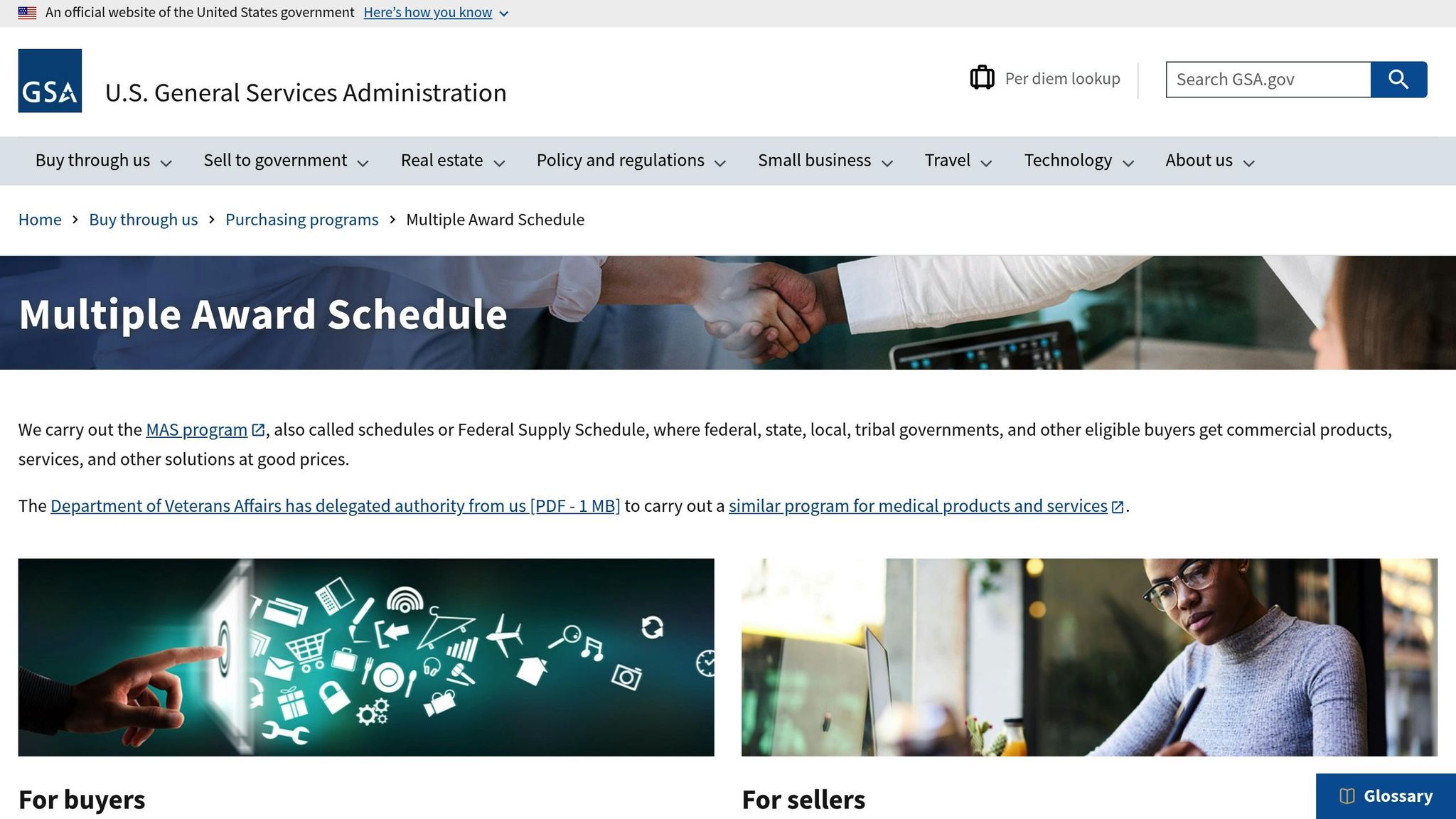The U.S. government spends billions daily on contracts, offering businesses opportunities to secure federal work through structured procurement methods. Here’s what you need to know:
- Key Programs: The GSA Schedule program facilitated $45 billion in spending in 2023, yet only 4% of small businesses participate.
- Simplified Processes: Tools like GSA eBuy and GSA Advantage connect businesses with government buyers.
- Competition Insight: Nearly 44% of federal contracts receive only one bid, leaving room for small businesses to stand out.
Main Procurement Methods
- Micro-Purchases: For contracts under $10,000, with minimal paperwork and no competitive bidding.
- Simplified Acquisition Procedures (SAP): For contracts up to $250,000, designed for small businesses with limited competition.
- Sealed Bids: Used for contracts over $250,000, awarded to the lowest bidder.
- Request for Proposals (RFPs): For complex projects, focusing on technical expertise and past performance.
- Single-Source Contracts: Direct awards to unique vendors without competition.
Why It Matters
Federal procurement ensures fair competition and responsible spending. Programs like the GSA Schedule offer businesses long-term contracts, reduced competition, and streamlined processes.
Quick Comparison
| Method | Dollar Range | Competition | Best For |
|---|---|---|---|
| Micro-Purchase | Under $10,000 | Minimal | Small, quick purchases |
| Simplified Acquisition | Up to $250,000 | Moderate | Small businesses |
| Sealed Bidding | Over $250,000 | High | Straightforward projects |
| RFP | Over $250,000 | High | Complex services or solutions |
| Single-Source | Any amount | None | Unique vendor requirements |
Understanding these methods helps businesses navigate federal contracts, secure steady revenue, and access larger opportunities.
Types of procurement process
Main Federal Procurement Methods
Federal procurement uses a range of methods to ensure purchases are conducted with fairness and transparency. These processes are guided by the Federal Acquisition Regulation (FAR), which provides a standardized framework for how federal agencies buy goods and services.
The FAR organizes procurement methods based on contract value and specific needs. For contracts under $250,000, agencies can use simplified acquisition procedures, making the purchasing process quicker and less complex. For contracts exceeding that amount, more formal approaches – like sealed bidding or negotiated procurement – are required. These methods are essential for managing the federal government’s massive budget, which includes billions spent daily. For instance, in 2023 alone, $45 billion was spent through the GSA Schedule program.
Why Procurement Methods Matter
Procurement methods are critical for ensuring fair competition and responsible use of taxpayer money. They play a key role in shaping how businesses engage with the federal market.
These methods impact access to opportunities, reduce competition in certain cases, speed up sales processes, and ensure compliance with federal standards. For companies entering the federal space, understanding these methods isn’t just about following the rules – it’s a strategic way to build reliable revenue streams.
Each method is tailored to meet specific goals and offers unique benefits. Take the GSA Schedule program, for example. It allows businesses to face fewer competitors and negotiate prices just once, making it an attractive option for those seeking long-term federal contracts. By understanding these methods, businesses can better position themselves to succeed in the federal marketplace, setting the stage for the more detailed procurement categories discussed in the next sections.
Small-Scale Procurement Methods
Small-scale procurement helps simplify lower-value purchases, cutting down on paperwork while ensuring transparency.
Micro-Purchases Under $10,000
Micro-purchases are the easiest type of federal procurement, designed for quick and low-cost transactions. Federal agencies can complete these purchases directly with very little paperwork or competition requirements, often using government-issued credit cards for immediate payments.
Key aspects of micro-purchases include:
- No need for competitive quotes
- Instant transactions using government credit cards
- Minimal paperwork
- Fair distribution among qualified vendors
- Freedom to buy directly from any qualified supplier
Simplified Buying Up to $250,000
Simplified Acquisition Procedures (SAP) make it easier to handle purchases between $10,000 and $250,000. This approach balances efficiency with oversight, offering small businesses a great way to enter federal contracting while ensuring fair competition.
The SAP process typically involves three steps:
-
Request for Quotation (RFQ)
Agencies post their requirements and request quotes from vendors. While this process is less formal than full-scale competitive bidding, proper documentation is still required. -
Limited Competition
Agencies aim to gather at least three quotes when possible, ensuring fair competition without unnecessary delays. -
Small Business Emphasis
SAP purchases are structured to create opportunities specifically for small businesses.
Simplified buying has proven effective. For instance, in 2023, $45 billion was spent through the GSA Schedule program. Small businesses can improve their chances of success with simplified acquisitions by:
- Keeping solid past performance records
- Responding quickly to quote requests
- Meeting all basic requirements
- Building strong relationships with agency buyers
- Learning about specific agency preferences
For businesses looking to establish steady revenue, these procurement methods are a great starting point in federal contracting. With nearly 44% of government awards receiving only one bid, competition may be less intense than expected, opening up real opportunities for well-prepared vendors.
These small-scale approaches pave the way for larger, more formal procurement processes covered in the next section.
sbb-itb-8737801
Large-Scale Procurement Methods
Handling large-scale procurement involves detailed processes and thorough documentation. These methods are typically used for contracts over $250,000 or projects with complicated technical needs.
Sealed Bid Process
The sealed bid process is used when price is the sole deciding factor. Agencies outline their requirements and set a strict deadline for bid submissions.
Key steps include:
- Public Bid Opening: Bids are opened at a set time in a public forum.
- Awarding Contracts: The contract goes to the lowest bidder who meets all requirements.
- No Negotiations: Once bids are opened, prices cannot be negotiated.
This approach works best when the project specifications are clear and straightforward.
Request for Proposals (RFP)
The RFP process is used when factors like technical expertise, past work, and creativity are as important as cost. Unlike sealed bids, this method is designed for more complex projects.
The process includes:
- Initial Release: The agency shares the project requirements, evaluation criteria, and submission guidelines.
- Proposal Development: Companies create detailed proposals covering technical plans, management strategies, and pricing.
- Evaluation Process: Proposals are reviewed based on technical quality, past performance, cost, and participation of small businesses.
- Negotiations: Agencies may seek clarifications, discuss pricing, or adjust project details.
This method is often used for projects like custom software development or consulting. Successful proposals highlight technical skills, solid project management, reasonable pricing, a track record of success, and strong quality assurance.
Both the sealed bid and RFP processes demand strict compliance with submission rules. These structured approaches open doors to high-value federal projects, transitioning from simpler to more intricate procurement methods.
Special Procurement Types
Federal agencies use specific methods to simplify procurement processes. These approaches are designed to handle unique scenarios and make purchasing more efficient through established programs.
Single-Source Contracts
Single-source contracts let agencies award contracts directly to one vendor without a competitive bidding process. This approach is used only when one vendor is uniquely qualified to meet the agency’s needs, making the usual competitive process unnecessary.
Another key method, the GSA Schedule Program, offers additional ways to simplify procurement for both agencies and vendors.
GSA Schedule Program

The GSA Schedule Program simplifies purchasing by providing pre-negotiated terms, access to pre-approved vendors, and less competition. It operates through platforms like GSA eBuy and GSA Advantage.
"The GSA Program delivers High-Value, Low-Competition Bids for 20 Years."
For businesses looking to enter federal contracting, securing a GSA Schedule contract can be challenging due to strict requirements and compliance standards. Expert services like GSA Focus can assist with tasks such as document preparation, ensuring compliance, and supporting negotiations, making the process more manageable.
These specialized procurement methods align with broader federal strategies, paving the way for a detailed comparison of methods in the next section.
Procurement Methods Side-by-Side
Understanding federal procurement methods can help you choose the strategy that aligns with your contracting goals. Each approach has its own purpose and benefits in the federal marketplace.
Method Comparison Chart
Here’s a breakdown of common federal procurement methods:
| Procurement Method | Dollar Range | Competition Level | Best For |
|---|---|---|---|
| Micro-Purchase | Under $10,000 | Minimal | Small, immediate needs |
| Simplified Acquisition | Up to $250,000 | Moderate | Standard commercial items |
| Sealed Bidding | Over $250,000 | High | Construction and supply contracts |
| RFP Process | Over $250,000 | High | Complex services |
| Single-Source Contracts | Any amount | None | Unique, sole-source requirements |
| GSA Schedule Program | Any amount | Low to moderate | Long-term contracts with shorter sales cycles |
The GSA Schedule Program stands out for its streamlined processes, offering shorter sales cycles, larger contract values, reduced marketing costs, and contract terms that can last up to 20 years.
Despite these advantages, only 4% of small businesses currently hold GSA Schedule contracts. For businesses that meet the program’s requirements, this opens the door to a major competitive edge. On average, companies leveraging the GSA Schedule report an additional $927,000 in steady revenue.
This chart highlights the strengths of each method, making it easier to identify the best approach for your business. By understanding these options, you can make informed decisions that align with your capabilities and growth plans.
Conclusion
Federal procurement methods offer businesses a way to secure government contracts tailored to various needs. Each year, billions of dollars are allocated through these structured programs, making them an important part of succeeding in federal contracting.
One standout option is the GSA Schedule program, which connects businesses to high-value contracts while facing less competition. The relatively low participation rate presents a major opportunity for companies ready to engage with the federal marketplace. As Josh Ladick, Founder of GSA Focus, puts it:
"Every day you’re not on GSA, you’re missing out on $50m+ in opportunities"
Many businesses using the GSA Schedule program report notable revenue growth by aligning their offerings with the right procurement channel. Whether starting small with micro-purchases under $10,000 or aiming for larger contracts through the GSA Schedule, success hinges on understanding these pathways and navigating them effectively. While federal requirements can be strict, expert support simplifies the process and opens up significant opportunities. With this knowledge, businesses are better equipped to tackle the challenges of federal contracting.
Related posts
- How to Read GSA Solicitation Documents
- Key Terms in GSA Contracts Explained
- How GSA Contracts Impact Federal Construction Compliance
- GSA Ordering vs Open Market Purchasing


